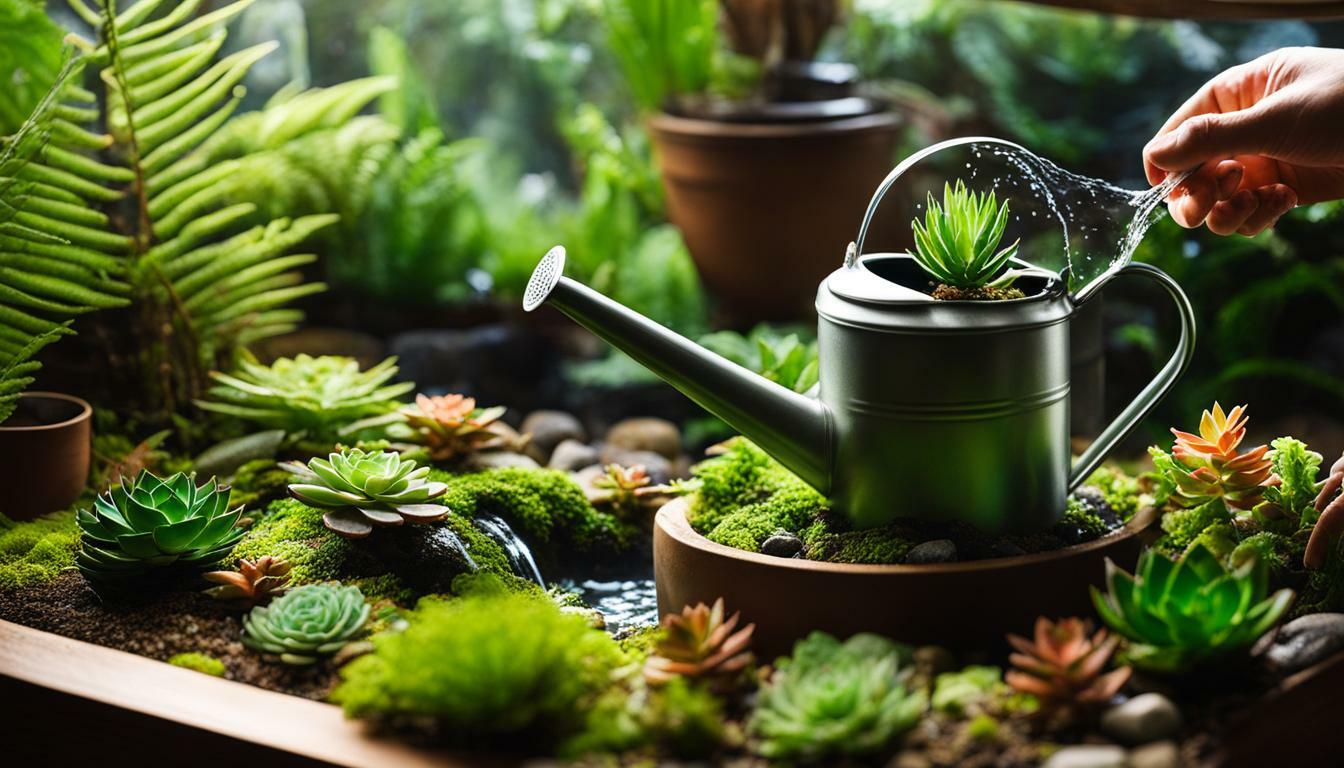Terrariums are a beautiful addition to any space, but proper care and maintenance are vital to ensure their longevity and beauty. In this comprehensive guide, we will provide you with all the essential information you need to know about caring for terrariums and maintaining their water features. Whether you’re a beginner or an expert, this guide will help you master the art of terrarium care and water features maintenance.
- Proper positioning is crucial for terrarium survival, with closed terrariums needing to be placed away from windows and open terrariums requiring full or partial sunlight.
- Watering frequency varies for open and closed terrariums, with succulents and cacti needing weekly watering in open terrariums and closed terrariums maintaining their own humidity levels.
- Pruning and removing overgrown plants is necessary to maintain aesthetic balance within the terrarium ecosystem.
- Regular cleaning and maintenance are essential to avoid bacterial and fungal issues in terrariums.
- Proper placement and avoiding direct sunlight are important factors for ensuring the health and longevity of your terrarium.
Understanding Terrariums: Types and Positioning
Terrariums come in various types, including closed and open terrariums, each requiring different positioning to create an optimal environment for plant survival. Closed terrariums are best placed away from windows to prevent direct sunlight, which can cause excessive heat buildup. On the other hand, open terrariums thrive when positioned in areas with full or partial sunlight, allowing the plants to receive the necessary light for photosynthesis.
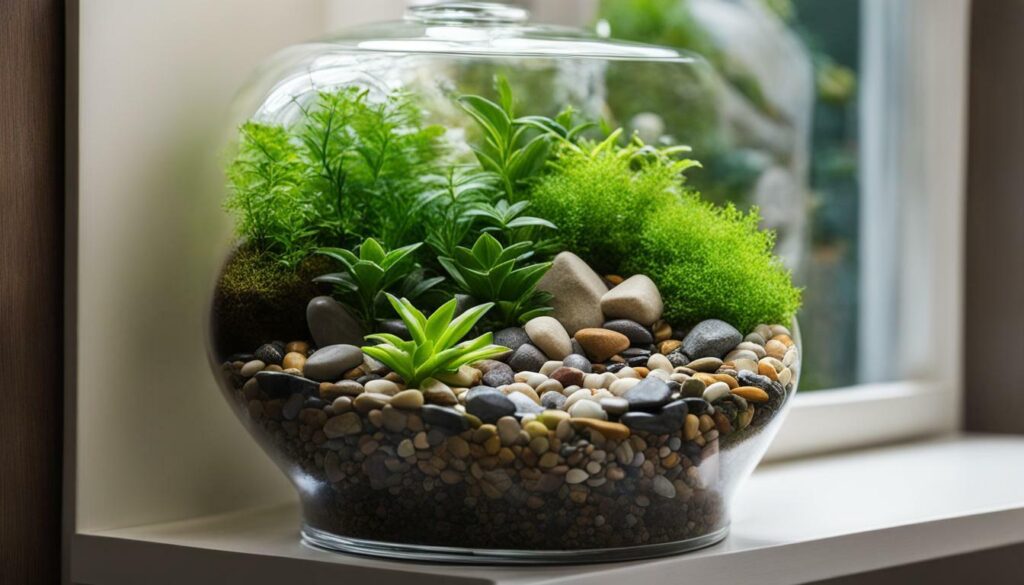
In a closed terrarium, a clear glass or plastic container creates a miniature greenhouse, trapping moisture and creating a humid environment. This setup is ideal for plants that thrive in high humidity, such as ferns and mosses. The closed terrarium should be placed in an area with moderate light, away from direct sunlight, to prevent excessive heat and moisture buildup. Placing it near a north-facing window or using artificial grow lights can provide the necessary brightness without overheating the terrarium.
Open terrariums, on the other hand, require more exposure to light and air circulation. Plants such as succulents and cacti, which prefer drier conditions, thrive in open terrariums. These terrariums can be placed near a south or west-facing window to ensure they receive ample sunlight. However, it’s essential to monitor the temperature and humidity levels, as excessive heat and dryness can still be detrimental to the plants.
Types of Terrariums
| Terrarium Type | Positioning | Plants Suitable |
|---|---|---|
| Closed Terrarium | Away from direct sunlight | Ferns, mosses, tropical plants |
| Open Terrarium | Partial to full sunlight | Succulents, cacti, desert plants |
Understanding the type of terrarium you have and the positioning it requires is essential for creating a thriving mini ecosystem. By providing the right amount of light and humidity, you can ensure that your plants flourish and enjoy a long and healthy life.
Watering Frequency for Terrariums: Open vs. Closed
Proper watering is essential for the health and well-being of your terrarium, and the frequency varies depending on whether you have an open or closed terrarium.
In open terrariums, such as those housing succulents and cacti, weekly watering is typically necessary. These plants thrive in drier conditions, so it’s important to allow the soil to dry out between waterings. Overwatering can lead to root rot and other issues, so it’s crucial to find the right balance.
On the other hand, closed terrariums create a self-watering ecosystem that maintains its own humidity levels. The glass container traps moisture, creating a mini greenhouse for the plants inside. As a result, closed terrariums require less frequent watering. In fact, overwatering can lead to excessive moisture buildup and can harm the plants. It’s important to monitor the moisture levels within the closed terrarium and only water when necessary.
Watering Frequency Guidelines
Here are some general guidelines to help you determine the watering frequency for your open and closed terrariums:
- Open terrariums: Water once a week or when the soil feels dry to the touch. Remember, it’s better to underwater than overwater.
- Closed terrariums: Monitor the moisture levels by checking the condensation on the glass. If there is excessive condensation, it’s a sign that the terrarium has enough moisture and doesn’t need watering.
Remember to use filtered or distilled water when watering your terrarium to avoid chemicals or impurities that can harm the delicate ecosystem.
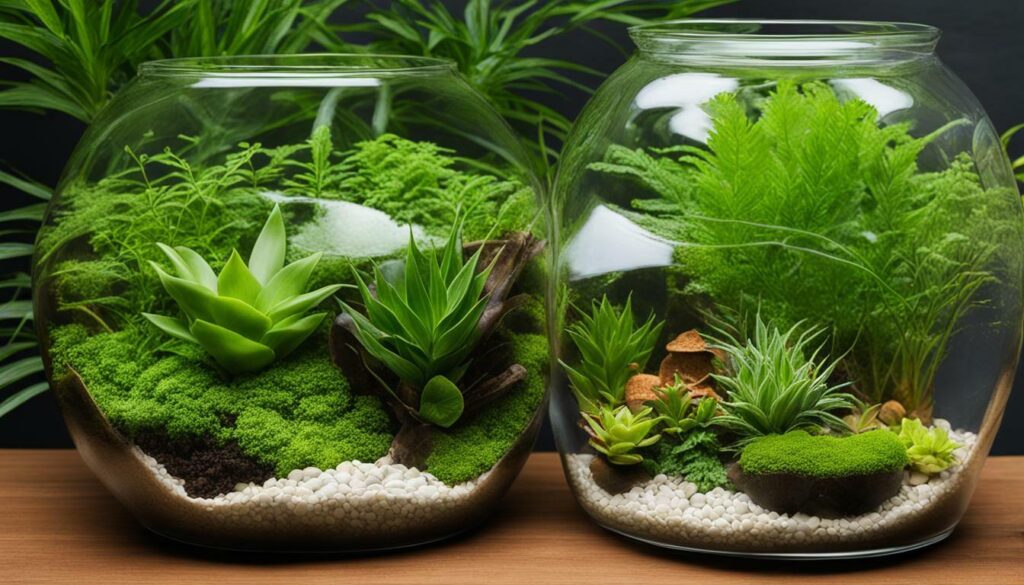
| Terrarium Type | Watering Frequency |
|---|---|
| Open Terrarium | Once a week or when soil feels dry |
| Closed Terrarium | Only water when condensation is minimal |
“Proper watering is crucial for a thriving terrarium ecosystem. Understanding the unique needs of your particular terrarium type will help you ensure the health and longevity of your plants.”
Pruning and Removing Overgrown Plants
As your terrarium plants flourish, it’s important to regularly prune and remove any overgrown plants to ensure the optimal growth and balance of your terrarium. Over time, certain plants may outgrow their allocated space, causing overcrowding and potentially hindering the overall health of the ecosystem. Pruning not only enhances the aesthetic appeal of your terrarium, but it also promotes healthier plant growth and prevents any potential damage or competition for resources among plants.
When pruning your terrarium, it’s essential to use clean, sterilized tools to avoid introducing any harmful bacteria or diseases. Gentle trimming of overgrown leaves and stems should be done carefully to prevent damage to neighboring plants. Remove any dead or decaying plant material promptly to maintain the cleanliness of the terrarium and prevent the risk of bacterial or fungal issues.
“Pruning is an art that requires a delicate touch. By carefully removing overgrown plants, you can maintain the balance and harmony within your terrarium ecosystem.” – Terrarium Enthusiast
While pruning, it’s also an opportune time to check for any signs of pests or disease. Inspect the plants and soil closely for any abnormalities, such as discoloration, wilting, or pest infestations. If you notice any issues, take immediate action to rectify the problem, whether it’s adjusting watering habits, applying organic pest control methods, or seeking professional advice.
| Pruning Tips: | Benefits of Pruning: |
|---|---|
|
|
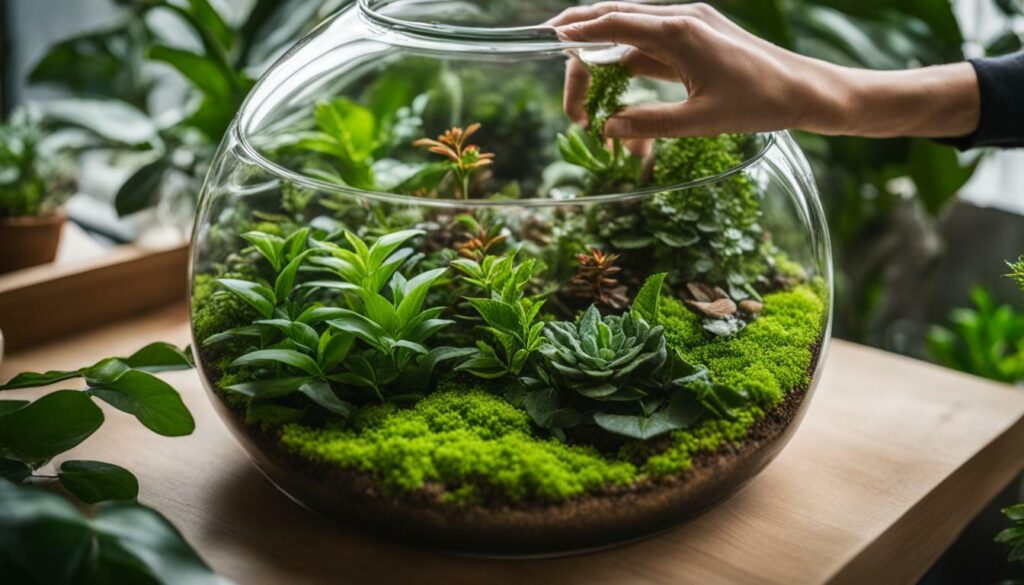
Remember, maintaining the proper balance within your terrarium is key to its long-term success. By regularly pruning and removing overgrown plants, you can create an environment where all the inhabitants thrive while showcasing the beauty of nature’s miniature world. Take the time to care for your terrarium, and you’ll be rewarded with a stunning and flourishing display.
Keeping Terrariums Clean: Avoiding Bacterial and Fungal Issues
To maintain a healthy and thriving terrarium, it’s crucial to keep it clean to prevent the growth of bacteria and fungi that can harm your plants. Regular maintenance tasks such as removing dead leaves and cleaning the glass surfaces will go a long way in ensuring the longevity of your mini-ecosystem.
When it comes to cleaning your terrarium, remember to handle it with care. Terrariums are delicate and can easily break if mishandled. Use a soft cloth or sponge soaked in a mild soapy solution or vinegar-water mixture to wipe down the glass. Be gentle when cleaning, especially near fragile plants or delicate decorations.
In addition to regular cleaning, keep an eye out for signs of bacterial or fungal issues. If you notice any unusual growth, discoloration, or a foul smell, it may indicate an infection. In such cases, isolate the affected area immediately and remove any infected plants or decaying organic matter. You can also apply a natural fungicide or bactericide to prevent the spread of the infection.
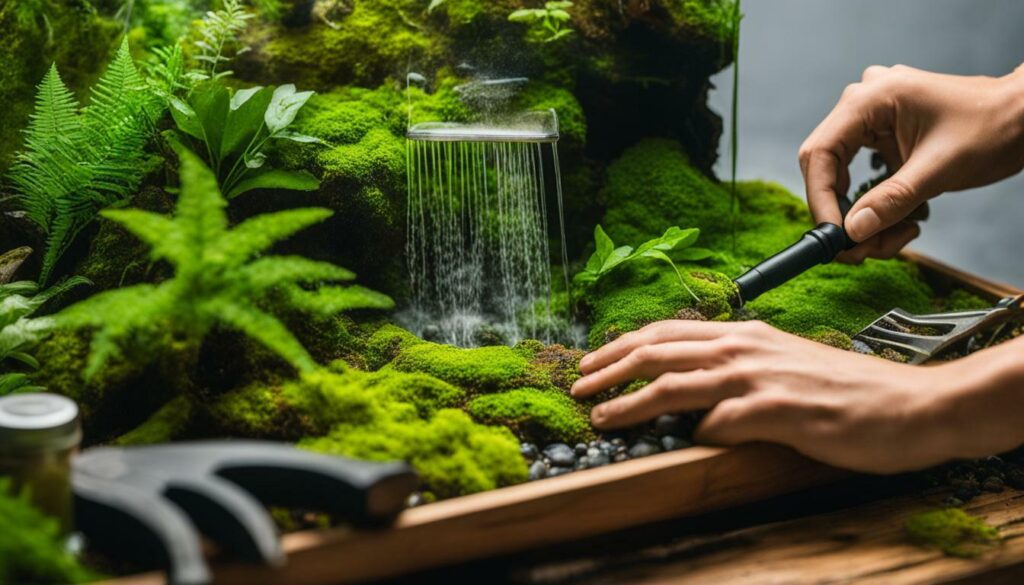
While terrarium care may seem straightforward, there are common mistakes that many enthusiasts make. Avoid these pitfalls to ensure your terrarium thrives:
- Overwatering: Excess water can lead to root rot and the growth of harmful bacteria. Follow proper watering guidelines for your specific terrarium type.
- Using dirty tools: Always use clean, sterilized tools when working with your terrarium. Dirty tools can introduce harmful bacteria or fungi into the ecosystem.
- Neglecting ventilation: Proper airflow is essential for preventing moisture buildup and the growth of mold or mildew. Ensure your terrarium has adequate ventilation.
- Ignoring signs of stress: Pay attention to your plants and look out for signs of stress, such as wilting or yellowing leaves. Address any issues promptly to prevent further damage.
“Terrariums are beautiful, self-contained ecosystems that require some care and attention to keep them thriving.”
Conclusion
Keeping your terrarium clean and free from bacterial and fungal issues is essential for the health and longevity of your plants. By following the proper cleaning techniques, avoiding common mistakes, and promptly addressing any issues that arise, you can enjoy a beautiful and thriving terrarium ecosystem for years to come.
| Common Mistakes to Avoid | Terrarium Care Tips |
|---|---|
| Overwatering | Follow proper watering guidelines for your specific terrarium type. |
| Using dirty tools | Always use clean, sterilized tools when working with your terrarium. |
| Neglecting ventilation | Ensure your terrarium has adequate ventilation to prevent moisture buildup. |
| Ignoring signs of stress | Pay attention to your plants and address any signs of stress promptly. |
Proper Placement for Terrarium Health
Finding the perfect spot for your terrarium is key to its overall health and well-being, as direct sunlight and improper placement can have detrimental effects. Terrariums are a delicate balance of light, temperature, and moisture, and finding the right environment for them to thrive is crucial.
When selecting a location for your terrarium, it’s important to consider the lighting conditions. While some terrariums thrive in bright, indirect light, others prefer more shade. Closed terrariums, such as those housing ferns or moss, should be positioned away from direct sunlight to prevent overheating and excessive moisture buildup. On the other hand, open terrariums with succulents or cacti require exposure to full or partial sunlight to ensure proper growth.
Temperature is another factor to consider when placing your terrarium. Most terrariums prefer a temperature range of 65-75 degrees Fahrenheit (18-24 degrees Celsius). Avoid placing your terrarium near drafty windows or heat sources as this can disrupt the delicate balance of temperature and humidity.
Lastly, consider the humidity levels in the area where you plan to place your terrarium. While closed terrariums provide their own self-sustaining humidity, open terrariums may require additional moisture in drier environments. Placing a tray of water near the terrarium or misting the plants regularly can help maintain the ideal humidity levels for their growth.
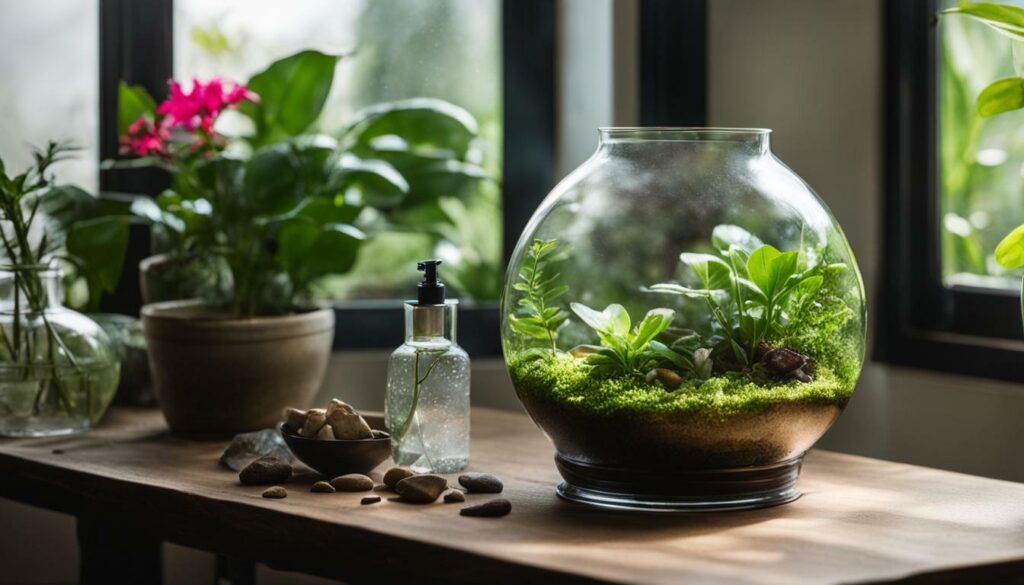
By carefully considering the lighting, temperature, and humidity levels, you can create an ideal environment for your terrarium to thrive. Remember to monitor your terrarium regularly and make any necessary adjustments to ensure its health and longevity.
The Benefits of Terrarium Water Features
Incorporating water features into your terrarium not only adds beauty but also brings a host of benefits to the overall ecosystem. The soothing sound of trickling water creates a calming atmosphere, enhancing the ambiance of any space. Additionally, water features help to regulate humidity levels within the terrarium, creating a favorable environment for plant growth.
One of the key advantages of terrarium water features is their ability to provide hydration to the plants. As the water cycles through the system, it moisturizes the soil and roots, ensuring that the plants receive the necessary moisture they need to thrive. This is particularly important for terrariums housing plants that require consistent moisture, such as ferns and mosses.
The addition of water features in a terrarium can also promote air circulation. The movement of water creates a gentle breeze, helping to prevent the development of stagnant air pockets and mold growth. This contributes to the overall health of the terrarium ecosystem, minimizing the risk of bacterial and fungal issues.
Furthermore, water features act as a focal point, adding visual interest and creating a dynamic landscape within the terrarium. The flowing water adds movement and life, complementing the lush greenery and vibrant colors of the plants. It provides a captivating centerpiece that captures attention and creates a sense of tranquility.
| Benefits of Terrarium Water Features: |
|---|
| Enhances ambiance and creates a calming atmosphere |
| Regulates humidity levels within the terrarium |
| Provides hydration to plants |
| Promotes air circulation and prevents mold growth |
| Adds visual interest and creates a dynamic landscape |
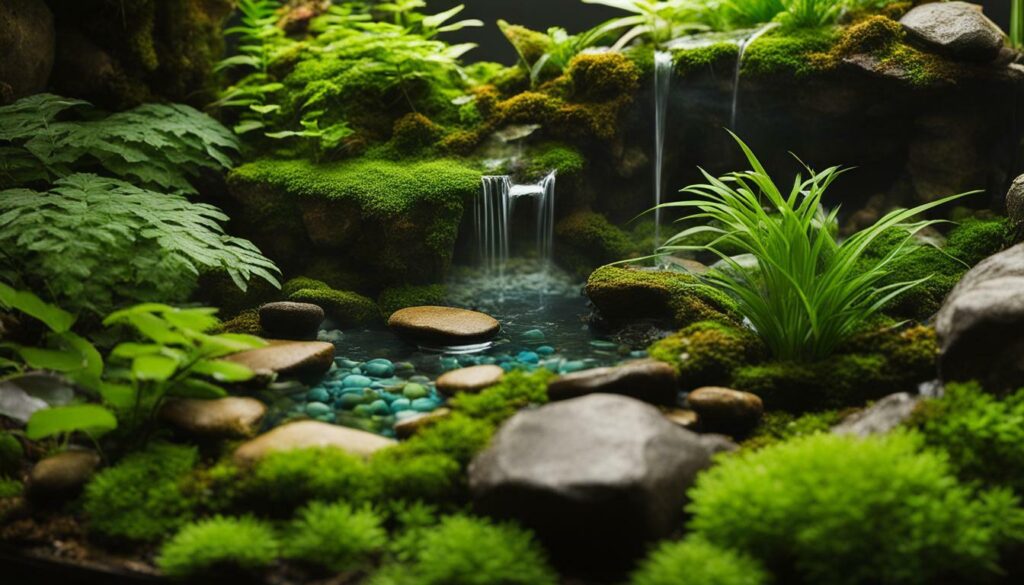
Water features in terrariums serve not only as aesthetic enhancements but also as functional elements. They contribute to the overall health and well-being of the plants, creating a harmonious environment that mimics the natural habitats of the plants. By incorporating a water feature into your terrarium, you can elevate its beauty and enjoy the multitude of benefits it brings.
By understanding the importance of water features and implementing proper maintenance techniques, you can ensure that your terrarium thrives, providing you with a captivating and serene natural display.
Maintaining Terrarium Water Features
Learn how to effectively maintain your terrarium water features to ensure they remain functional and contribute to the overall health of your terrarium. Proper maintenance of these features is essential for their longevity and the well-being of the plants and animals within the terrarium ecosystem.
One of the key aspects of maintaining terrarium water features is keeping the water clean and free from debris. Regularly remove any fallen leaves, twigs, or other organic matter that may accumulate in the water. This will help prevent the buildup of bacteria and algae, ensuring a healthy environment for your terrarium inhabitants. Additionally, consider adding a small filter or water pump to improve water circulation and oxygenation.
Another important aspect to consider is monitoring the water levels in your terrarium. Check the water levels regularly and top up as needed to maintain a consistent level. Be mindful not to overfill the terrarium with water, as this can lead to root rot and other water-related issues for your plants. It’s always better to have slightly less water than too much.
Lastly, it’s crucial to check and maintain any water feature components, such as pumps, filters, or decorative elements. Ensure that these components are clean, functioning properly, and not causing any disturbances in the water flow or balance. Regularly inspect for any leaks or signs of damage, and make necessary repairs or replacements to keep your terrarium water features in optimal condition.
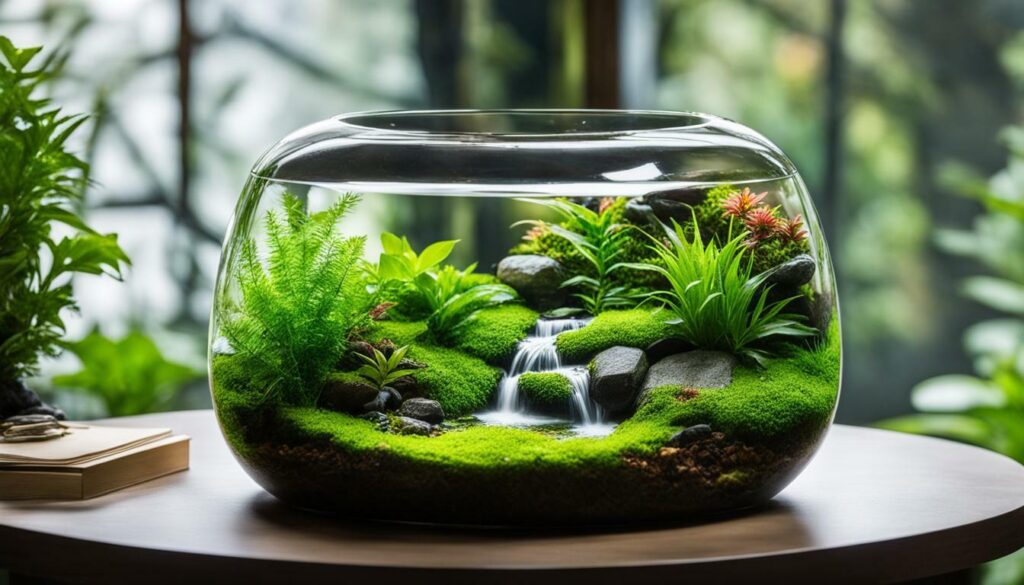
Maintaining terrarium water features requires regular attention and care, but the results are well worth it. By following these maintenance tips, you can create a beautiful and thriving water ecosystem within your terrarium. Remember to keep the water clean, monitor the levels, and maintain the components for the best results. Your terrarium and its inhabitants will thank you for it!
The Art of Terrarium Water Care
Mastering the art of terrarium water care is essential to create and maintain a thriving ecosystem within your terrarium. Terrariums are low maintenance and create a self-watering ecosystem, but understanding the specific needs of your terrarium water is crucial for its overall health.
When it comes to watering your terrarium, the frequency varies depending on whether it’s an open or closed terrarium. For open terrariums, especially those housing succulents and cacti, weekly watering is usually required. It’s important to monitor the moisture level of the soil and avoid overwatering, as it can lead to root rot. Closed terrariums, on the other hand, maintain their own humidity levels and generally require less frequent watering.
In addition to watering, maintaining cleanliness is important to prevent bacterial and fungal issues. Regular maintenance such as removing dead leaves and cleaning the glass surfaces will help keep your terrarium clean and healthy. Avoid using harsh chemicals or cleaning agents, as they can harm the delicate balance of the ecosystem.
| Terrarium Water Care Tips |
|---|
| 1. Water open terrariums once a week, monitoring soil moisture levels. |
| 2. Closed terrariums require less frequent watering due to their self-sustaining ecosystem. |
| 3. Clean your terrarium regularly by removing dead leaves and wiping the glass surfaces. |
| 4. Avoid using harsh chemicals or cleaners that can disrupt the terrarium ecosystem. |
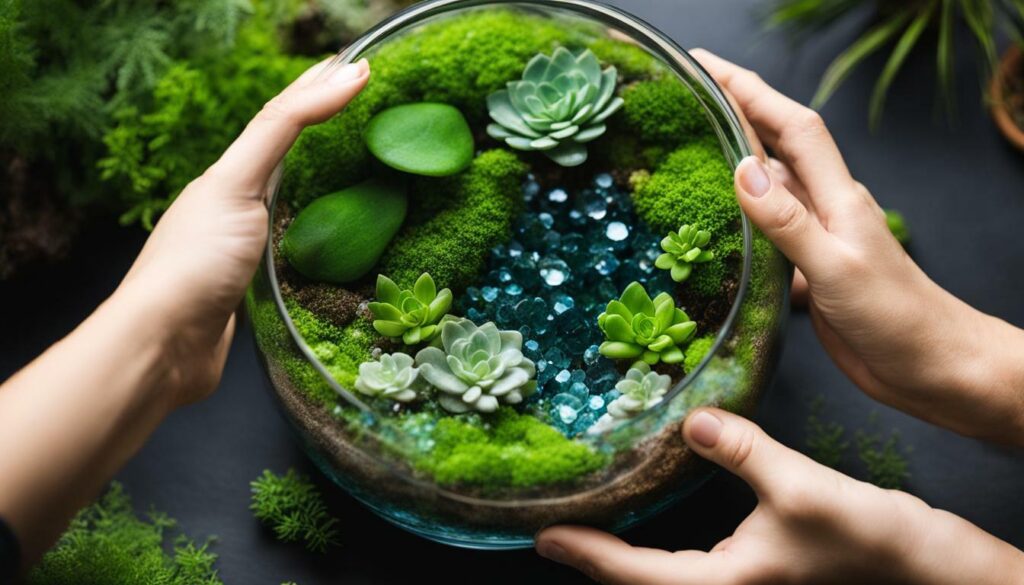
Remember, the key to a successful terrarium is finding the right balance. Providing the right amount of water and maintaining cleanliness will help create a healthy and thriving ecosystem. By mastering the art of terrarium water care, you can enjoy the beauty of your terrarium for years to come.
Terrarium Maintenance Tips: A Comprehensive Guide
Discover a range of valuable tips and tricks to effectively maintain your terrarium, ensuring its health and beauty for years to come. Terrariums are a popular choice for plant lovers due to their low maintenance and ability to create self-watering ecosystems. However, proper care is still necessary to keep your terrarium thriving.
Positioning is key when it comes to terrariums. Closed terrariums, such as those housing tropical plants, should be placed away from direct sunlight to prevent overheating. On the other hand, open terrariums, which often contain succulents or cacti, need exposure to full or partial sun to ensure optimal growth.
Watering frequency is another crucial aspect of terrarium care. Open terrariums with succulents and cacti typically require weekly watering, as these plants prefer drier environments. In contrast, closed terrariums create their own humidity levels and generally do not require additional watering.
| Quick Tip: | Check the moisture level of your terrarium’s soil before watering. Stick your finger about an inch into the soil – if it feels dry, it’s time to water; if it’s still moist, hold off on watering. |
|---|
Regular pruning is essential to maintain the aesthetics and balance within your terrarium. As the plants grow, some may become overgrown or start competing for space and resources. Carefully trim and remove excess plants to create a harmonious environment for all inhabitants of your terrarium.
“Pruning your terrarium plants not only helps control their size, but it also encourages healthy growth and prevents overcrowding. Remember to use clean, sharp pruning tools to avoid damaging the plants.”
Keeping your terrarium clean is vital to prevent bacterial and fungal issues. Regular maintenance, such as removing dead leaves and cleaning the glass surfaces, will help maintain a healthy environment for your plants. Avoid using harsh chemicals or cleaners, as they can harm your terrarium’s delicate ecosystem. Instead, opt for mild soap or vinegar diluted in water.
Proper Placement and Sunlight
The placement of your terrarium plays a significant role in its overall health. Avoid placing it in direct sunlight, as this can cause excessive heat, leading to plant damage. Instead, find a spot in your home or office that offers bright, indirect light.
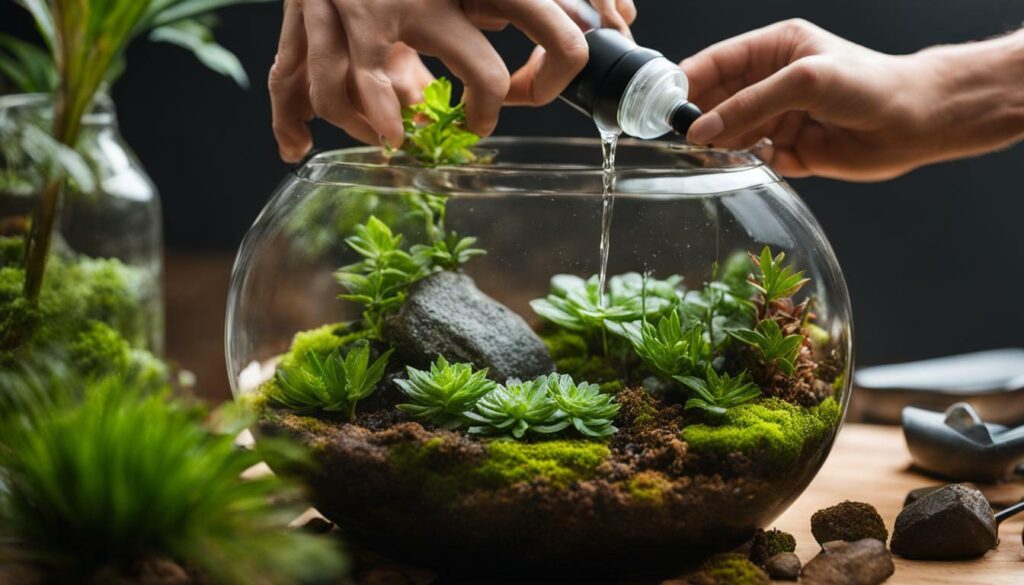
By following these terrarium maintenance tips, you can ensure the longevity and beauty of your miniature garden. With a little care and attention, your terrarium will continue to delight and thrive for years to come.
Are Water Features Maintenance Different from Terrarium Care?
Yes, mastering terrarium and water feature care requires different maintenance. While both require attention to water levels and cleanliness, terrariums need controlled humidity and plant care, while water features demand pump and filter maintenance to keep the water clear and flowing properly.
Common Mistakes to Avoid in Terrarium Care
Learn from the common mistakes made in terrarium care and avoid them to maintain the health and beauty of your own terrarium. Taking proper care of your terrarium is essential to ensure the well-being of the plants and the longevity of the ecosystem. By being aware of these common pitfalls, you can establish a thriving terrarium that brings joy and tranquility to your space.
One common mistake is improper watering. Overwatering or underwatering can lead to root rot or plant dehydration, respectively. It is crucial to understand the watering needs of your specific terrarium type and adjust accordingly. Open terrariums housing succulents, for example, should be watered weekly, while closed terrariums maintain their own moisture levels.
Another mistake is neglecting pruning and removing overgrown plants. As your terrarium plants grow, they may outgrow their designated space. Neglecting to prune or remove overgrown plants can disrupt the balance within the ecosystem and hinder the overall aesthetics. Regular pruning is necessary to maintain a well-maintained and visually appealing terrarium.
Keeping your terrarium clean is also vital. Failure to regularly clean the glass surfaces and remove dead leaves can lead to bacterial and fungal issues. These issues can compromise the health of your plants and negatively impact the overall ecosystem. Regular maintenance, such as wiping the glass and removing debris, is essential to prevent these problems.
Common Mistakes to Avoid in Terrarium Care:
- Improper watering: Overwatering or underwatering can harm the plants.
- Neglecting pruning: Failure to remove overgrown plants can disrupt the ecosystem balance.
- Not keeping it clean: Regular cleaning prevents bacterial and fungal issues.
By avoiding these common mistakes in terrarium care, you can ensure the health and beauty of your own terrarium. A well-cared-for terrarium will bring a touch of nature and serenity to any indoor space.
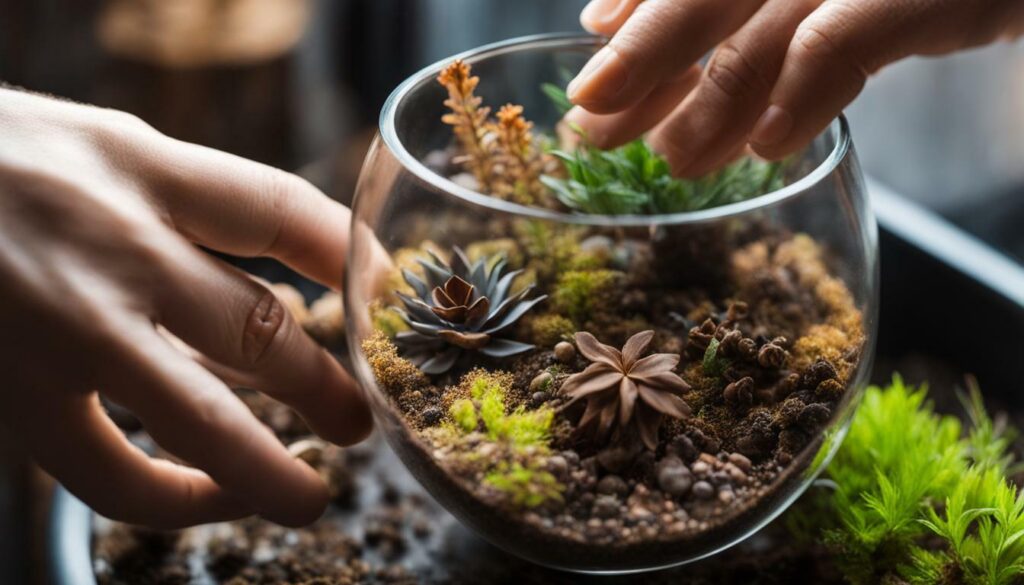
With the knowledge and insights gained from this comprehensive guide, you are well-equipped to care for your terrarium and its water features, ensuring their longevity and beauty.
Terrariums are a popular choice for plant enthusiasts due to their low maintenance nature and the creation of a self-watering ecosystem. However, proper care is essential to ensure the health and wellbeing of the plants within.
Positioning your terrarium correctly is key to plant survival. Closed terrariums should be placed away from windows to avoid excessive heat and direct sunlight, while open terrariums require exposure to full or partial sun.
Watering frequency is also an important aspect of terrarium care. Open terrariums, especially those housing succulents and cacti, typically require weekly watering, while closed terrariums can maintain their own humidity levels.
Regular pruning and removal of overgrown plants is necessary to maintain the aesthetics and balance within the terrarium ecosystem. Additionally, keeping the terrarium clean is crucial to avoid bacterial and fungal issues. Removing dead leaves and cleaning the glass surfaces regularly will help prevent these problems from arising.
Proper placement of the terrarium is vital for its overall health. Avoiding direct sunlight and finding the right spot in your home or office, depending on the light requirements of the plants, will ensure your terrarium thrives.
With the knowledge gained from this guide, you can fully appreciate the benefits of terrarium water features. They not only enhance the aesthetics but also provide additional benefits to the terrarium ecosystem.
Finally, maintaining the water features within your terrarium is essential for their longevity and functionality. By following the tips and techniques provided in this guide, you can keep your water features in optimal condition.
By following the comprehensive guide on terrarium maintenance, you can enjoy the beauty and serenity of your terrarium for years to come. With proper care and attention to detail, your terrarium and its water features will thrive, creating a stunning focal point in any space.
FAQ
What are the different types of terrariums and how should they be positioned?
There are closed terrariums, which should be placed away from windows, and open terrariums, which need full or partial sunlight exposure.
How often should I water my terrarium?
The watering frequency depends on whether it is an open or closed terrarium. Open terrariums, especially with succulents and cacti, typically require weekly watering, while closed terrariums maintain their own humidity levels.
How do I prune and remove overgrown plants in my terrarium?
Pruning and removing overgrown plants is necessary to maintain the aesthetics and balance within the terrarium ecosystem. Regular pruning with sharp, clean tools and removing excess plants carefully will help keep your terrarium healthy.
How can I avoid bacterial and fungal issues in my terrarium?
Keeping your terrarium clean is crucial to prevent bacterial and fungal issues. Regular maintenance, such as removing dead leaves and cleaning the glass surfaces, will help avoid these problems.
What is the proper placement for a terrarium?
Proper placement is important for the overall health of your terrarium. It is recommended to avoid direct sunlight and find the right spot in your home or office where your terrarium can thrive.

